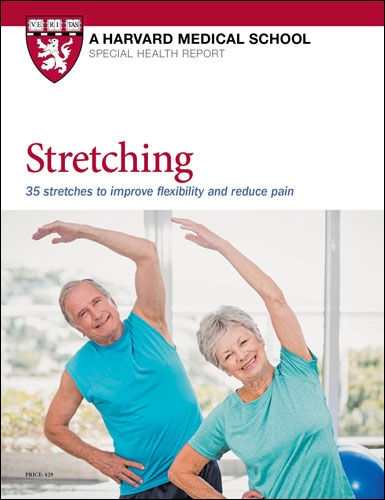Harvard Health Blog
What to do with that foam roller at the gym?

The foam roller is possibly the least intimidating piece of equipment in the gym. It's light. It's no-tech. And like most things in the gym, you've heard something about its benefits, seen a few people using it, and wonder if you should be doing the same.
What is myofascial release?
Foam rolling is a myofascial release technique. The fascia is a sheet of fibrous connective tissue made of collagen that surrounds muscles. It holds muscles in place and helps them glide through their range of motion, says Carina O'Neill, DO, medical director of Spaulding Outpatient Center–Braintree. Think of the relationship like an orange cut in half, she suggests: the edible sections are the muscle, the surrounding white part is the fascia.
Whether you use massage, chiropractic care, or foam rolling, when you press on one tissue, you unavoidably press on the other. There are spots where only fascia is being worked, such as the bottom of the foot and the iliotibial band that runs along the outside of your upper leg, but mostly it's a combination.
Why is myofascial release performed?
Muscles and fascia can become tight from overuse, repetition, body mechanics, and weakness. In response, the body may protect itself by limiting your range of motion. That protection can be a benefit, except when it doesn't allow the body to heal itself or move freely.
"Muscles tighten up for a reason, but sometimes they don't get the memo that they can loosen up because there's no tissue damage," Dr. O'Neill says. "Muscles can be stupid."
How can a foam roller help?
Myofascial release techniques manipulate tissue in order to return it to the proper position and looseness. For example, with massage a therapist would feel the muscle, sensing changes in texture and tenderness, and use pressure to stretch and soften up the tissue, Dr. O'Neill says. The challenge is that sometimes myofascial pain and the source of it are not in the same place. Pain running down the legs could be from tightness in the glutes. Headaches can be from tightness in the trapezius muscles.
The limited research about foam rolling comes from short-term studies of specific sports or even specific muscles. Most studies are small and some involve performing intense activities, such as box jumps, or foam rolling for an extended period of time. Within this context, there is evidence that foam rolling helps with delayed onset muscle soreness (DOMS), recovery, muscle fatigue, and range of motion. Another possible use for a foam roller, Dr. O'Neill says, is during a warm-up for exercise to enhance flexibility.
How should I use a foam roller?
Consider foam rolling a tool to try — an option if you find it helps with your warm-up or eases muscle stiffness, rather than a mandatory segment of your exercise routine. Target big muscle groups — the glutes, legs, back — and slowly roll over an area. Once you hit the "hurt so good spot," as O'Neill calls it, use your body weight to roll back and forth, moving only about two to six inches. The area could be tender at first, so start with five to 10 seconds to make it more pliant. As you become more accustomed to foam rolling, you can work up to 15 to 30 seconds.
Any exercise-related activity comes with caveats. If pain causes you to clench or grimace, stop rolling. Post-exercise soreness (DOMS) is normal and should resolve within two to four days. Lingering pain reflects a bigger problem and you should call your health care provider for advice. Finally, even if rolling initially feels good, start slowly and don't overdo it. If you roll too vigorously or for too long, you can cause tissue damage. "Too much of anything is a bad thing," Dr. O'Neil says.
About the Author

Steve Calechman, Contributor
Disclaimer:
As a service to our readers, Harvard Health Publishing provides access to our library of archived content. Please note the date of last review or update on all articles.
No content on this site, regardless of date, should ever be used as a substitute for direct medical advice from your doctor or other qualified clinician.
















